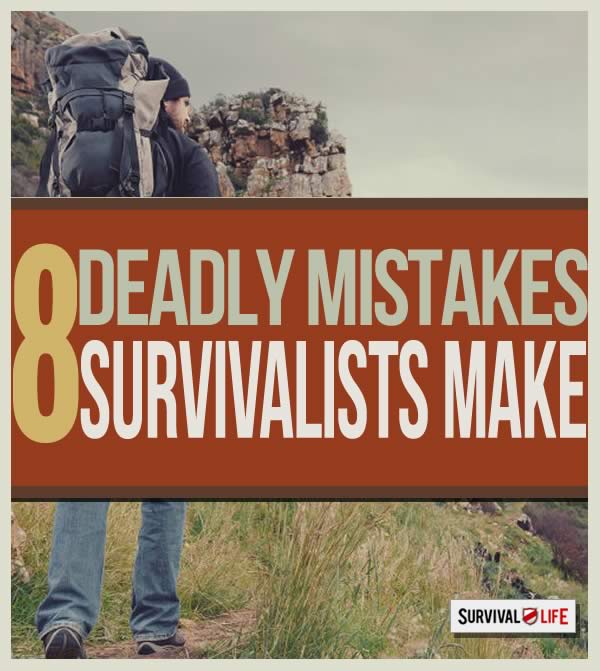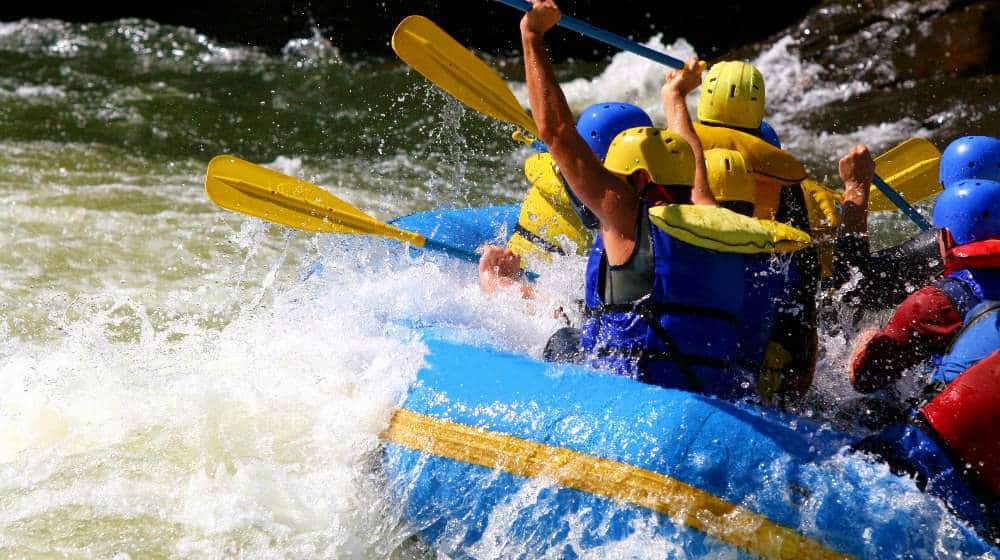Emerging Threats
Bug Out the Right Way | Avoid These Deadly Wilderness Survival Mistakes

Nothing could be worse when SHTF than deciding to bug out but not really knowing what to do.
As survivalists, we know to always be prepared. Finding a bug out location is only the first step. Outdoor survival skills are crucial if you want to not just bug out for a while, but have a chance of surviving in the wild no matter how long you’re out there.
Bug Out the Right Way: Avoid These Deadly Wilderness Survival Mistakes
If you already know your basic wilderness survival skills, you should practice them by scheduling a camping trip once in a while. Think of these camping trips as a refresher course.
For those who are new to the idea of preparedness and survival, welcome to the Outdoor Survival Skills 101 crash course.
Click here to read the full post.
Surviving in the Wild: 8 Deadly Mistakes to Avoid When You Bug Out
In the time before a crisis, bug out plans must be tested and retested to ensure they meet all of the wilderness group’s needs. This is the time to replace leaders or fix major problems in the basic plan. After each change in the plan, the group needs to practice the new plan and evaluate the results to insure the plan is the best that it can be.
A proper step when making those plans is to identify your weaknesses and learn how to work around them. For that reason, see what are the usual mistakes and learn how to avoid them when surviving in the wilderness or camping in order to stay safe.
A Bad State of Mind
Whether you are surviving in the wilderness or just camping out with friends it is very important to take the situation seriously. One little mistake or an accident can be a life threatening event.
If you are too cocky or a know it all, your manner will portray you as a person that does not really care about what they are doing or what is going on. This can turn out to be a morale breaker and bring out the worst in people that have to work closely together.
Laziness or Stuck in a Rut
Being lazy or stuck in a rut is not a good state of mind in any wilderness camping trip. These individuals will slow down anything that they are assigned to do.
Most individuals that are affected with this problem usually spend more time trying to get out of work than it would have taken them to just do the job in the first place. Lazy individuals can endanger the whole camping group with their short cuts and not sticking to prepared set of procedures.
via Surviving in the Wild: 8 Deadly Mistakes to Avoid | Survival skills, survival guns, survival guide.
First you have to learn how to look for a good place to bug out.
You cannot keep running trying to escape the events in the city or somewhere else. The operative words are high and dry. Choose a location high enough to avoid being hit by a flood and one that will provide some form of shelter like a wall or rock formation. Stay away from loose tree limbs.
You should also know how to set up a tent if you brought one, or another way to build a decent bug out shelter. Resourcefulness is a vital trait in a bug out situation.
Starting a fire is also an essential survival skill since you need to keep warm and cook your food. If you don’t have a firestarter, try a battery. Knowing how to gather firewood is also important.
Ideally you should bug out in a place close to a water source because water is even more important than food.
Speaking of food, you must know how to find food like fruits, and if you’re lucky, vegetables. Hunting, trapping and fishing should also be in your arsenal of survival skills.
You need navigation skills, too, so you can find your way back to your bug out location or avoid going in circles, which is very dangerous. Sending signals is also an essential skill, whether it is using smoke or mirrors; this is the best way to get help.
There are many other important skills that could save you out in the wild. What do you have to add? Let us know in the comments.
Check out some previous posts on this topic.
Before Bugging Out-Three Things That Might Save Your Life
Your First Bug Out Bag – 50 Essentials For Your Kit
Best Bug Out Locations | Where To Go When The SHTF
-

 Do It Yourself7 months ago
Do It Yourself7 months agoParacord Projects | 36 Cool Paracord Ideas For Your Paracord Survival Projects
-

 Do It Yourself9 months ago
Do It Yourself9 months agoHow To Make Paracord Survival Bracelets | DIY Survival Prepping
-

 Do It Yourself9 months ago
Do It Yourself9 months ago21 Home Remedies For Toothache Pain Relief
-

 Do It Yourself10 months ago
Do It Yourself10 months agoSurvival DIY: How To Melt Aluminum Cans For Casting
-

 Exports8 months ago
Exports8 months agoAre Switchblades Legal? Knife Laws By State









TripodXL
November 5, 2014 at 4:00 PM
I think the biggest mistake made IS bugging out. Not that I don’t have a BOB, but it is a 3 day bag. If I had to leave an area to survive and escape a disaster, I can do that. Long term bugging out is a fantasy if you don’t have a BOL that is within a 3 day walk (30 miles). If it is any further than that the realistic chances of survival are low. People should LIVE at their BOL, period. If you have to BO, then driving better be part of it. Better yet would be to boat upstream…less traffic. You have to be able to get within a 3 day walk of your BOL because 30 miles from a metro area isn’t far enough. If you aren’t in RANGER, Airborne, triathalon or crucible shape…you aren’t going to BO with much for any distance. Forty pounds isn’t enough “stuff” to live on indefinitely and you aren’t going to hump a heavier pack any long distances. Have a plan, have a BOL and living in your BOL would be your best bet.
Robert Brenner
November 9, 2014 at 9:19 AM
Right on point TripodXL. Each time I hear a discussion on BO, memories of the movie “Independence Day” flood into my brain, and I recall the hundreds (thousands) of motor homes driving across the desert away from Los Angeles, and I think, “But out to where?” And what will you do when you get there? What about food? Water? Comfort? Sanitation? There’s much to consider and accommodate when “bugging out.” This is why posts like yours are so valuable to we who live on a vertical learning curve. Thanks for the post.
Ron Mc Cullough, USMC Retired
November 8, 2014 at 9:24 AM
Everyone should know how to use a compass n a topo map. Yes a fire is needed at times, but should not have a fire at night if you end up in a bug out. Because a fire at night might n will give you area away to un-welcome people that might want to harm you n love ones. Also assigne jobs to everyone. If they have different types of weapons, then make sure everyone knows how to use them.Sorry a little long winded. But there is
Robert Brenner
November 9, 2014 at 9:13 AM
With a family member working at a fire dispatch emergency center, I’ve learned much about what really happens in an emergency and what best to do to survive. Now I’m showing my family and friends how a solar panel can charge a battery, then to connect an inverter to the battery to convert DC to AC. I also explain how long that battery will provide energy before the inverter shuts down. Fascinating and fun because each thing you do to survive provides comfort knowing you CAN survive.
russ
November 10, 2014 at 5:57 AM
If you plan on a good location..even a small battery is 15 pounds easy. It can be carried…done it. Not worth it…
russ
November 10, 2014 at 6:12 AM
Water the most important resource. Don’t just rely on dry food. Without water you can’t eat it. Dried food just falls out of your mouth after a day with no water. Pack honey in your bob. At least A gallon of water for each day to get where you are going to. You realistically can’t pack in more than two gallons in a pack. A tent is just excess baggage. Lean-to plastic great temp shelter. Something that will start a fire under extremely wet conditions. Vaseline and cotton mixture works very well.
russ
November 10, 2014 at 6:38 AM
Plan a 24 hr excursion without water. You will quickly learn its importance. It will change everything you think you know about survival. A solar still will not provide enough water to survive in arid regions. Water purification tablets are a must have. Don’t eat anything you don’t absolutely know is safe. Study the plants in the area you plan on going to..you are not going to find veggies in your bug out spot. Knowing the plants that grow there will provide what you need.
Pingback: 10 Itens de Carros que Irão Ajudá-lo Quando o Colapso Chegar | Disso Você Sabia...? FATOS
Pingback: Wilderness Survival: What to Eat in the Wild | My Emergency Preparedness Blog
Pingback: Wilderness Survival: What to Eat in the Wild » Survival Gear & Food Storage
Pingback: Wilderness Survival: What to Eat in the Wild - Survival Life | Outdoor Survival Gear & Skills, SHTF Prepping
johnadams
September 5, 2016 at 2:29 AM
ya, where ya gon bug out too,… back in daisy, they BUILD their own long term BMB shelter, with supplies…. ya think ya’ll gon go out an disperse in the wilderness,…. ya’ll gon fight over the same fungis/,mushroom,water source, etc. Key sentence here was,.. live your BOL or ya ain got a chance. p.s., dont leave distress signals, itl only attract the vultures/sharks ..drunk, using someone elses email,… good luck
Pingback: Bugging Out Is Not Always The Right Idea [PODCAST] – The Self-Sufficient Life
Pingback: Bugging Out Is Not Always The Right Idea [PODCAST] – surviveurself
Pingback: Bugging Out Is Not Always The Right Idea [PODCAST] – Alive After USA Fall
Pingback: Bugging Out Is Not Always The Right Idea [PODCAST] - Cooking in Quarantine
Pingback: Bugging Out Is Not Always The Right Idea [PODCAST] | Best Go Bag
Pingback: Bugging Out Is Not Always The Right Idea [PODCAST] – SurvivalHood